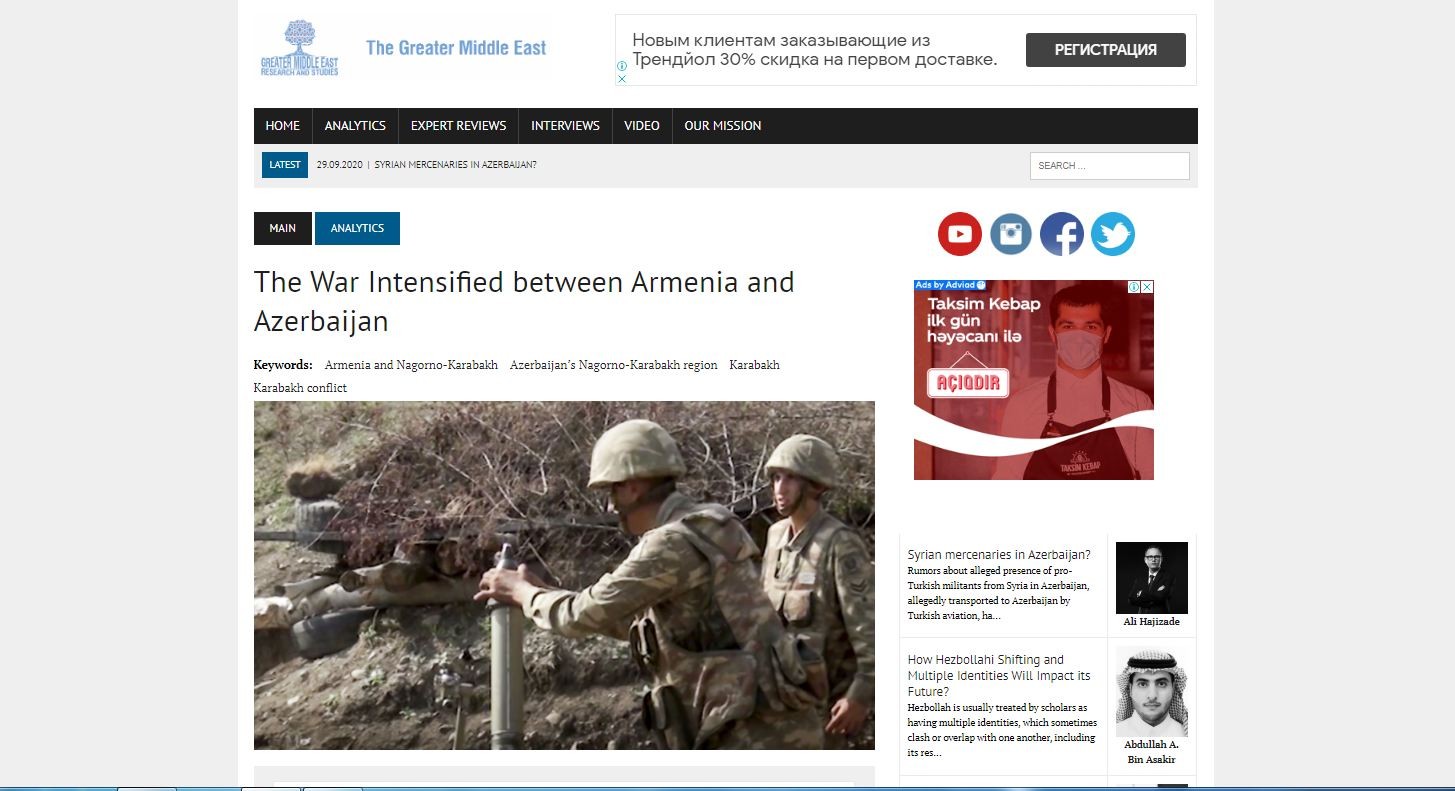On September 27, less than three months after the border confrontation between the sides on July 12-15, the conflict between Armenia and Azerbaijan escalated into the most intensive and largest hostilities since the establishment of the Russia-brokered ceasefire in May 1994.
Armenia’s armed forces started a large-scale provocation and fired at the positions of Azerbaijani army in the frontline zone and civilian settlement with large-caliber weapons, mortars and artillery of various calibers at about six o’clock in the morning, the Ministry of Defense of Azerbaijan reported.
“In order to suppress the combat activity of the armed forces of Armenia and ensure the safety of the civilian population, the command of the Azerbaijan Army decided to launch a counter-offensive operation of troops along the entire front,” the press-release of the Ministry read. Azerbaijan had mobilized personnel, tank units with the support of missile and artillery troops, front-line aviation and unmanned aerial vehicles.
The Armenian government accused Azerbaijan of the outbreak of the clashes, reporting that in the morning of September 27 that “the Azerbaijani army attacked the entire length of the line of contact with rocket-propelled grenade launchers and missile strikes”.
It was long reported by the local and international media that Russia had been shipping tons of arms to Armenia through complex transportation routes bypassing the shortest route via Georgia. Russia’s military supply was interpreted by the observers as a systemic preparation of Armenia’s armed forces for a new war. Condemning Russia’s arm supply, the Azerbaijani government warned of its destructive consequences for the peace and stability in the region.
“The Armenian Prime Minister announced the establishment of civilian militia consisting of tens of thousands of civilians who will be forced to undertake military actions against Azerbaijan. The minister of defense of Armenia calls for “new war for new territories”. Armenia threatens Azerbaijan to strike major cities, critical civilian infrastructures such as Mingachevir water reservoir and Sangachal terminal, which is one of the world’s biggest oil-gas terminals situated near Baku and providing energy security to tens of countries”, President Ilham Aliyev of Azerbaijan declared in his address to 75th session of United Nations General Assembly in a video format on September 24.
Shortly after the outbreak of the fighting, both countries declared martial law and mobilization. While Armenia called for general mobilization for reserves over 18 years old, Azerbaijan announced only a partial mobilization on September 28. It was reported by Leader of Armenion Union of Russia Ara Abramian that 20,000 Armenians living in Russia had applied to join the fight against Azerbaijan.
On September 27, the liberation of seven villages in Fuzulu and Jabrail region and some important heights was reported by the Defence Minister of Azerbaijan. The liberated territories included the Vardenis-Aghdara highway that connects Armenia and Karabakh and is of great importance for Yerevan for speedy transport of military cargo to the occupational regime in Karabakh. The loss of some positions was confirmed by the Armenian side on September 27.
According to the official statistics, Azerbaijan has lost six civilians including two schoolchildren as a result of Armenia’s shelling on the settlements along the frontline. No information has been shared by the Azerbaijani side about the number of military servicemen who have been killed in the fighting, while, according to the Armenia’s Defense Ministry, Armenia had lost at least 58 soldiers until the afternoon of September 28.
The warring states have been called by numerous states and international organizations, including the European Union, Russia and the United States, to cease fighting and return to the negotiations. Josep Borrell, EU’s High Representative, naming the situation in the region “worrying escalation”, called for “immediate cessation of hostilities, de-escalation and strict observance of ceasefire”. Meanwhile, Vardan Togonian, Armenia’s Ambassador in Russia, invited Russia to interfere and make the conflicting parties resume negotiations.
The OSCE’s Minsk Group, the main international mission tasked with the mediation of the peace negotiations between Armenia and Azerbaijan and co-chaired by Russia, France and the United States, called for “return to ceasefire and resumption of substantive negotiations”. Notably, the peacebuilding efforts of the Minsk Group have been complicated over the last few years, in particular due to the rejection of the Armenian government of the settlement formulations, including the Madrid Principles, proposed by this institution.
Disputing the whole essence of the negotiations, Armenia’s Foreign Minister declared in April 2020 that there was no document on the negotiating table. This statement was made in response to Russian Foreign Minister Sergey Lavrov, who previously expressed support to the existing “firmly established format of negotiations” and described the draft documents on the agenda to be a “very important step in implementing the [United Nations] Security Council resolutions.” The erosion of the negotiating process was admitted by President Aliyev on July 6, 2020, as he criticized the international mediators in the negotiations declaring that the peace process has become “meaningless”.
Against this backdrop, the approach of the Minsk Group to the conflict started to be extensively criticized in Azerbaijan both by the government and the general public. In particular, Azerbaijanis were outraged by the lame reaction of the institution to the provocative moves of the Armenians, which included the plan to move the “capital” of the occupational regime in the Nagorno-Karabakh region to the historical Azerbaijani town Shusha, the illegal settlement of Lebanese Armenians in the occupied territories, and the destruction of historical and religious monuments, including mosques, in the region under Armenian occupation. The admitted failure of the negotiations over the last three decades had been long warned as an indication of further intensification of the conflict.








